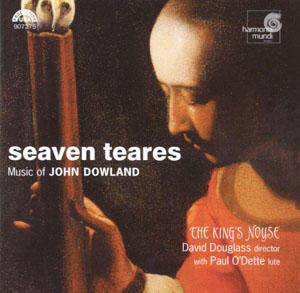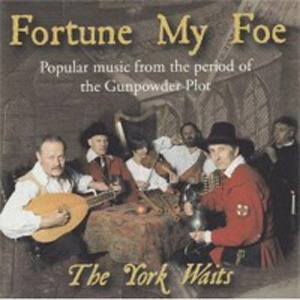There was a time not so long ago (well, geologically speaking, at any rate) when court music and popular music were not so far apart. Say about four hundred years, give or take a decade. (This is really to some extent a slight exaggeration — the minute I wrote it I remembered that The Magic Flute was written as a popular entertainment. It’s not so far off base, though.) This was brought home to me in my back-to-back listening of John Dowland’s Seven Teares and Fortune My Foe, popular music from the same period.
 John Dowland (1563-1626) is one of a bare handful of English composers from before the twentieth century who is generally considered worthy of note. The Lachrimae, or Seven Teares, issued in 1604, was perhaps his signature composition, based on a pavan most likely improvised during the 1590s that became an instant top-ten hit throughout Europe. Dowland’s music is part of that vast outpouring of the late Renaissance in northern Europe that included Michael Praetorius and Johan Schein.
John Dowland (1563-1626) is one of a bare handful of English composers from before the twentieth century who is generally considered worthy of note. The Lachrimae, or Seven Teares, issued in 1604, was perhaps his signature composition, based on a pavan most likely improvised during the 1590s that became an instant top-ten hit throughout Europe. Dowland’s music is part of that vast outpouring of the late Renaissance in northern Europe that included Michael Praetorius and Johan Schein.
The pavan, a “kind of staid music ordained for grave dancing,” according to Thomas Morley, whose comments were published in 1597 (and I don’t think the entendre was intentional), was pretty much a dead letter as a popular dance by the time Dowland and other English composers adopted it as a form. The linkage to “tears” seems to be an affectation of the age — high art and poetry were much concerned with lamentation and melancholy around the turn of the seventeenth century, no matter our perception of the Elizabethan Age, and although Dowland often touted himself as an afflicted soul whose art was rejected by the shallow (while drawing from Christian IV of Denmark the highest salary of any court employee anywhere in Europe), there is little to indicate whether this was more than marketing.
The collection on this disc includes not only the Seven Teares but songs from Dowland’s first and second books of songs (published, for some reason, in 1613 and 1600, respectively). Of particular note is “I saw my Lady weepe” from the Second Book of Songs, a new song that was paired with “Flow my teares,” the version of the original pavan for voice; the two bracket the seven pavans of the cycle as the last part of the collection. Soprano Ellen Hargis provides a touching and memorable interpretation over Paul O’Dette’s sensitive lute accompaniment. The cycle itself is, indeed, melancholy, which seems to be characteristic of much of Dowland’s music in particular. This same strain of sadness runs through the song selections as well.
The recording is quite a sequence of melancholy, frankly, but aptly done and engaging on several levels, and is accompanied by an extraordinarily informative booklet in English and French including an essay by Scott Metcalfe, commentary on the instruments used, and the texts of the songs.
(The King’s Noyse is David Douglass, violin, dir.; Robert Mealy, viola; Scott Metcalf, viola; Margriet Tindemans, viola in F; Emily Walhout, bass violin; and Elen Hargis, soprano. They can be found online at Noyse Productions.)
 Guy Fawkes made the mistake of getting caught with the barrels of gunpowder intended to blow up the Houses of Parliament in 1605; he was neither the instigator nor the leader of the plot, just the fall guy. He has the somewhat thin consolation of giving his name to the English holiday on which things explode. (Every country has one, you know.) The music collected in Fortune My Foe is exactly contemporaneous with Dowland’s cycle, but of quite a different character, which leads me to believe that the obsession with woe was a courtly thing.
Guy Fawkes made the mistake of getting caught with the barrels of gunpowder intended to blow up the Houses of Parliament in 1605; he was neither the instigator nor the leader of the plot, just the fall guy. He has the somewhat thin consolation of giving his name to the English holiday on which things explode. (Every country has one, you know.) The music collected in Fortune My Foe is exactly contemporaneous with Dowland’s cycle, but of quite a different character, which leads me to believe that the obsession with woe was a courtly thing.
William Marshall, in his comments on this disc, makes an interesting observation on the music of the late Renaissance, something I barely touched on in my comments on Dowland: it wasn’t until the 1960s that England again exported so much music to the rest of the world, which perhaps gives us a good indication of the vitality of English music of both periods.
This recording, which I found both intriguing and delightful, evinces an attitude that partakes of that vitality and a great deal of freedom, which is something that we sometimes forget when we think about the sixteenth and seventeenth centuries: a huge amount of music was composed for so-called “broken” consorts — what we would call a “scratch orchestra.” They normally consisted of violin, flute, bandora, cittern, and bass viol, but musicians often worked with what was available locally, as musicians tend to do. They were also very interested in new sounds (another link to the mid-twentieth century).
We also tend to forget that “currency” in the seventeenth century had quite a different meaning than it does today. Many of these songs date from the mid- to late sixteenth century — some possibly even earlier — and partake of what I can only call a “pan-European” style — “My Lady Harrison’s Puffe,” which sounded suspiciously like a work by Michael Praetorius, turns out to have been composed by John Dowland. These are popular songs, then, some of which had been popular for decades. (It’s worth noting that John Gay used similar material, including “Packington’s Pound,” which is in this recording, in The Beggar’s Opera in 1728 for the very good reason that the tunes were widely known and had been for some time, another indication that “popular” had a longer shelf-life then than it does now.)
In case anyone is wondering, as I was, about the name “The York Waits,” Marshall is also good enough to explain that the waits were the city of York’s band of salaried musicians, a common office in English cities of the period.
This collection is, as I mentioned, delightful — a good blend of sprightly dance tunes and more serious works, rendered on a wide variety of instruments that includes, in addition to the “standard” forces listed above, hurdy-gurdy, shawm, bagpipes, sackbut, curtal, and a few others. It all makes for a rich and absorbing experience. The booklet, in addition to comments on poor Guy Fawkes and the period in general, also includes brief commentaries on the individual selections.
(The York Waits is Tim Bayley, William Marshal, John Peel, Ian Richardson, Roger Richardson, Anthony Barton, and Susan Marshall. They can be found online at the York Waits Web site. For an intriguing look at what waits are about these days, check the official Web site of the International Guild of Town Pipers.)
(Harmonia Mundi, 2002)
(Beautiful Jo Records, 2005)
